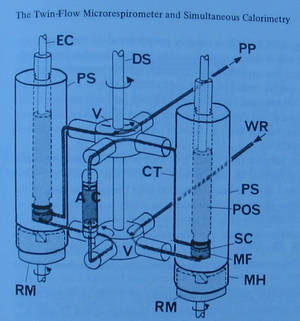From Bioblast
Oroboros Ecosystem history
- The production of the Oroboros O2k was preceeded by instrumental development of the Twin-Flow Microrespirometer (Gnaiger 1983) for simultaneous applications with microcalorimetry in an open-flow system (right). This Twin-Flow Microrespirometer was distributed on a small scale, but particularly applied in international cooperations (e.g. Hand SC, Gnaiger E, 1988. Anaerobic dormancy quantified in Artemia embryos: A calorimetric test of the control mechanism. Science 239: 1425-1427). For further references, see Gnaiger 1983 Springer POS Twin-Flow Respirometry.
- In 1989, the prototype of the O2k was developed in the frame of a FWF Project "Thermodynamics and respiratory control in aerobic and anoxic mitochondria" (E. Gnaiger, principal investigator).
- In 1992, the first series of the Oroboros O2k, or at that time the Oroboros Oxygraph, was completed (initially "Cyclobios Oxygraph" with Paar; Graz).
- In 1994, Oroboros® (founded by Erich Gnaiger) took over the world-wide distibution of the O2k. With completion of the development of DatLab 2 in cooperation with Dr. Michael Reck, the term "high-resolution respirometry" was coined. About 60 Oxygraphs were produced until 1998 and distributed in 17 countries.
- In 1997 Oroboros released DatLab 2, setting a new standard in software-supported high-resolution respirometry.
- In 2000, Oroboros Instruments Corporation (GmbH - Gesellschaft mit beschränkter Haftung) was founded.
- In 2001, Philipp Gradl (WGT Elektronik; Kolsass) started as the competent partner for development and production of the Oroboros O2k. Lukas Gradl (ssn - software security networks; Innsbruck) took over the software development, generating the refined Windows(TM) version of DatLab 3. All developments and production of the O2k takes place within 20 km of Innsbruck.
- As a result of this successful cooperation, 33 instruments of the O2k (Series A) were produced and delivered into 13 countries in 2002/2003.
- In August 2003, the first of 100 instruments of Series B were completed, and applied in a series of workshops on high-resolution respirometry. The O2k Series B provides the basis for integration of the Titration-Injection microPump (TIP-2k) and modular expansion to the multi-sensor O2k MiP-Net-Analyzer.
- 2004: 10 years Oroboros Instruments - MiPNet Meeting in September 2004.
- A major development was completed in 2004, to improve the design of the polarographic oxygen sensor (OROBoPOS), which is available since November 2004.
- Developments of the MultiSensor O2k-MiPNetAnalyzer benefit from user innovation. Based on the expertise and cooperation within MiP-Net, various electrochemical sensors (NO, ion selective electrodes such as pH, TPP, Ca2+, K+) and optical sensors (light scattering, fluorescence probes), can be integrated into the O2k and supported by the multichannel-software DatLab 4 (Windows™). Since December 2004, DatLab 4 and the MultiSensor O2k-MiPNetAnalyzer are available, including the Titration-Injection microPump TIP-2k and input channels for high-power amplification of ion-selective electrodes.
- 2006: In June 2006, the O2k #100 was sold (Series B).
- 2007: Since January 2007, the Oroboros Instruments Corporation (GmbH) replaced the previous private company in the world-wide distribution and service of the Oroboros O2k and accessories. VAT-No.: ATU 49093608. In May 2007, the first O2k of Series C was delivered.
- 2009: Oroboros Instruments celebrated the 50th International Course on high-resolution respirometry and cover-to-cover the 1st O2k-MultiSensor Workshop (April 2009, Schröcken, Vorarlberg, Austria). In February 2009, the O2k #200 was sold (Series C). The new Series D was compleded and delivered since November 2009.
- 2010: Bioblast wiki: Together with MitoPedia, OroboPedia was started by Oroboros Instruments on 2010-07-12 as a glossary and index to our website, in an attempt to help the users finding particular topics more quickly, and to provide short definitions of terms, abbreviations and symbols frequently used in the context of high-resolution respirometry and mitochondrial physiology.
- 2011: O2k-Series E. Launch of the K-Regio project 'MitoCom Tyrol' on 2011-05-01.
- 2012: Concept of the O2k-Core and Oroboros O2k-Catalogue - Jan 2012. First O2k-Fluorescence Workshop March 2012. First prize HOUSKA Award for 'Light in the Powerhouse of the Cells' - Apr 2012.
- Bioblast 2012: Conference on Mitochondrial Competence - Dec 2012.
- 2015: The 100th O2k Workshop was held in Schroecken,AT
- 2016: O2k-Series G was completed.
- 2017: Oroboros celebrates 25 years. A celebration in the spirit of Gentle Science and the new Series H, with O2k-FluoRespirometry as an extension of high-resolution respirometry (HRR) using the new "two in one" O2k-FluoRespirometer. Another big event in 2017 was the release of the software DatLab 7.
- 2018: Release of DatLab 7.3
- 2019: NextGen-O2k project began
- 2019: Foundation of MitoFit Preprint Archives (now MitoFit Preprints - the Open Access preprint server for mitochondrial physiology
- 2019: Received the Cluster Award 2019, awarded for the best Tyrolean innovations of the year, we are proud to be the 2019 Cluster Award recipient in the Life Sciences Cluster for our EU Horizon 2020-funded NextGen-O2k project.
- 2020: Launch of the new Oroboros company website » https://www.oroboros.at/www.oroboros.at
- 2020: Launch of Bioenergetics Communications - the open-access journal for bioenergetics, mitochondrial and chloroplast physiology
- 2020: Virtual training sessions offered: Virtual O2k-Workshop and O2k-Virtual Support
- 2021: 4,000 O2k-Publications on Bioblast
- 2022: Bioblast 2022 - BEC inaugural conference
- 2022: New O2k-Products released - NextGen-O2k, O2k-PB-Module, O2k-Q-Module, O2k-NADH-Module, Oxia, Sample Holder
- 2022: For our innovation “Oxia”, we – in collaboration with our mechatronics partner WGT-Elektronik – received the Cluster Award 2022 in the category Life Science.
- 2022: Introduced O2k-Network Award
- 2023: O2k-Series J - compatibility with PB, integrated computer






